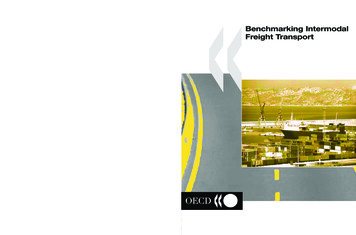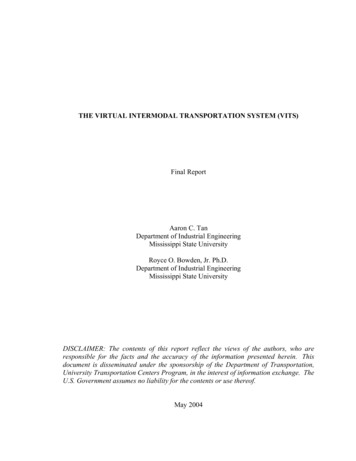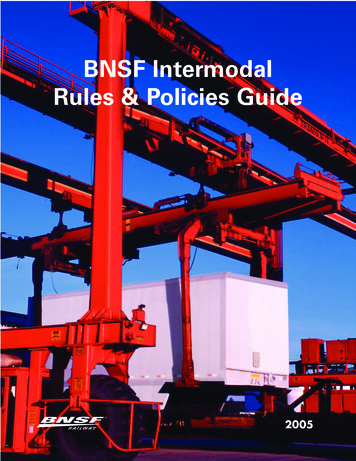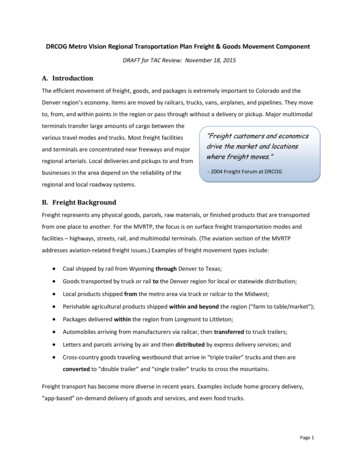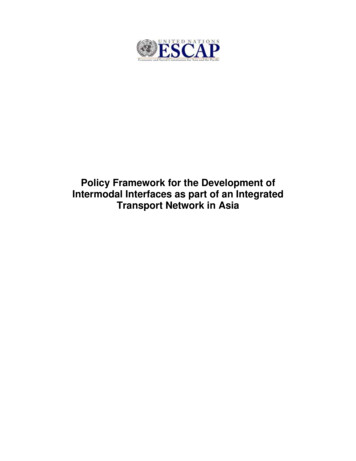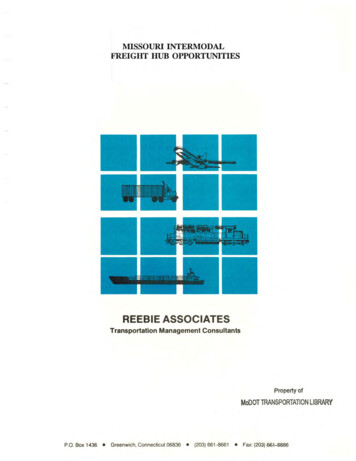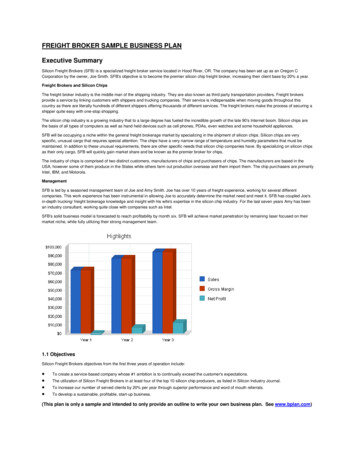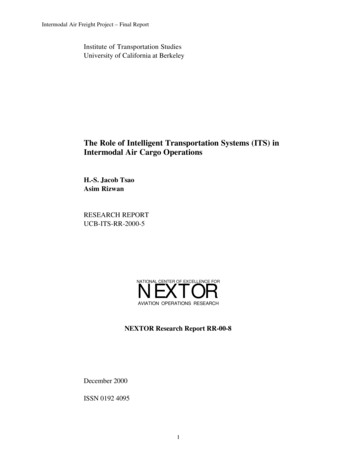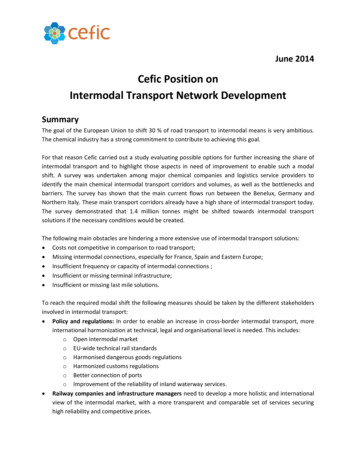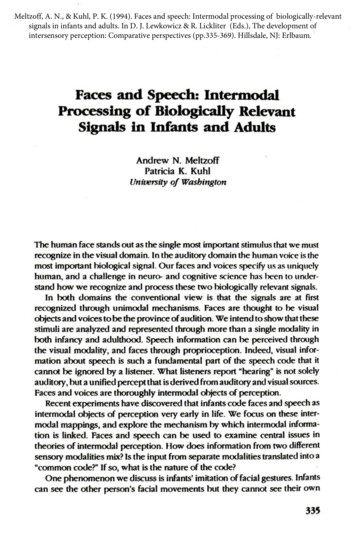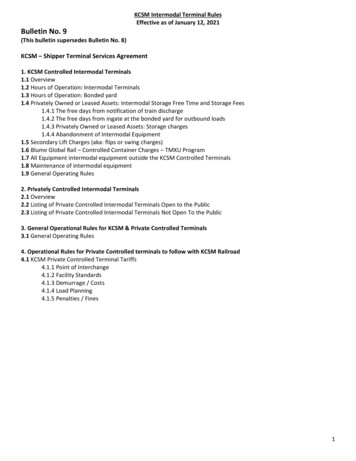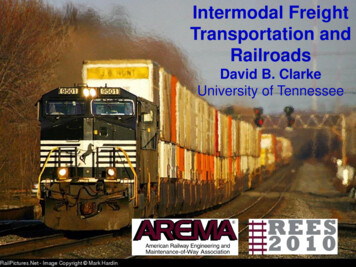
Transcription
Intermodal FreightTransportation andRailroadsDavid B. ClarkeUniversity of TennesseeREES Module #4 - Railway Intermodal Transportation1
Definition Intermodal shipment: a freight shipmentthat moves between origin anddestination using two or more modes oftransportation Types of intermodalism: Growth of unitized intermodal shipmentshas been a spectacular trend intransportationREES Module #4 - Railway Intermodal Transportation2
Intermodal Operations Service marketed by railroad, motorcarrier, steamship line, or third party Roles of modes Terminal facilities provided by port,steamship line, railroad, customer, orthird partyREES Module #4 - Railway Intermodal Transportation3
Types of Service Railroad intermodal transportation istypically described as either: These categories no longer cover all typesof service (e.g., RoadRailer) Current intermodal rail cars don’tnecessarily resemble flatcars.REES Module #4 - Railway Intermodal Transportation4
REES Module #4 - Railway Intermodal Transportation5
Rail Intermodal Traffic Growth Railroads began offering TOFC service inthe late 1950s Trailer Train Corporation (now TTX) wasformed to handle equipment pool COFC service paralleled the rise of marinecontainers Rise of global trade propelled COFCgrowth during 1980sREES Module #4 - Railway Intermodal Transportation6
HISTORIC GROWTHAnnual Intermodal Volumes(Sources: AAR & 00520102015YearThe economic recession has affected recent intermodal trends, in common with all freight movement.REES Module #4 - Railway Intermodal Transportation7
Recent Traffic TrendsREES Module #4 - Railway Intermodal Transportation8
Intermodal Truck/RailComparisonSource: BNSF RailwayTruckIntermodal TrainREES Module #4 - Railway Intermodal Transportation9
Relative Costs89’ railcar with TOFC0.5589’ railcar with COFC0.53Double stack railcar0.41RoadRailer0.57Truck1.00REES Module #4 - Railway Intermodal Transportation10
Intermodal Containers Allow unitized movement of goods Domestic and international versions Configurations include box, tank, flatbed Stackable DimensionsREES Module #4 - Railway Intermodal Transportation11
Sea Box, Inc.REES Module #4 - Railway Intermodal Transportation12
Chassis arenormally usedfor movementof containersover thehighway,althoughflatbed trailerscan be used Sea Box, Inc.REES Module #4 - Railway Intermodal Transportation13
Intermodal Trailers Common lengths are 28 ft, 48 ft, 53 ft;width is 102 in max. 80,000 lb GVW with tractor Modified construction to withstandrailroad service loads All configurations used; dry van andrefrigerator most commonREES Module #4 - Railway Intermodal Transportation14
Trailer and Container Use TrendsHigh volume ofimport/export trade drivescontainer growth Domestic container trafficis small, but growing TOFC service focused ondomestic market TOFC growth limited by Source: IANAREES Module #4 - Railway Intermodal Transportation15
REES Module #4 - Railway Intermodal Transportation16
REES Module #4 - Railway Intermodal Transportation17
Mechanized LoadingTechnology Gantry crane Side loader Straddle loader Reach loaderREES Module #4 - Railway Intermodal Transportation18
Marine Gantry CranesREES Module #4 - Railway Intermodal Transportation19
Rubber Tired Straddle LoaderREES Module #4 - Railway Intermodal Transportation20
Side LoaderREES Module #4 - Railway Intermodal Transportation21
Reach LoaderImage from Mi-Jack Products, Inc.REES Module #4 - Railway Intermodal Transportation22
Lift Spreader AssemblyREES Module #4 - Railway Intermodal Transportation23
Carless TechnologiesREES Module #4 - Railway Intermodal Transportation24
REES Module #4 - Railway Intermodal Transportation25
1.2.3.4.5.6.Hostler trailer positions trailer.Trailer air suspension lifts rear of trailer, tractor backs trailer onto rail bogie.Trailer air suspension is vented. Steel coil springs lift tires clear of rail.Tractor backs trailer to coupling with balance of train.Tractor leaves leading trailer on landing gear. Air lines are connected and landing gear is raised on second trailer.Rail locomotive backs CouplerMate to trailer. Air lines are connected and landing gear is raised on all trailers.Source: Wabash National CorporationREES Module #4 - Railway Intermodal Transportation26
Intermodal Terminal Elements Provision for loading/unloading railcars Box storage (long term or temporary) Vehicle storage (railcars/trailers/chassis) Check-in/check-out control Vehicle and box servicing/repair Security and lighting Office and administration Information systems Vehicle scalesREES Module #4 - Railway Intermodal Transportation27
Roberts Bank, BC Marine TerminalImage from GoogleEarthREES Module #4 - Railway Intermodal Transportation28
Marion, AR Intermodal Terminal Image from GoogleEarthREES Module #4 - Railway Intermodal Transportation29
Factors in Terminal Location Access to railroad and highway system Area, configuration, and topography of siteCost to acquire site and provideinfrastructureAdjacent land usesProximity to customer baseAbility to accommodate future growthLocal supportREES Module #4 - Railway Intermodal Transportation30
Terminal Design Low volume ( 100,000 annual lifts) Medium volume (100,000-500,000 annual lifts) High volume ( 500,000 annual lifts) In all cases, a linear design is preferableREES Module #4 - Railway Intermodal Transportation31
Future Issues for Intermodalism Improving the railroad system Funding needed improvements Developing a short-haul intermodal systemREES Module #4 - Railway Intermodal Transportation32
Intermodal Trains and RailwayInfrastructure Intermodal trains must be service competitive with trucks Train lengths to 7,500 ft routine; may reach 10,000 ft ifconditions permit Double stack trains need adequate clearances (20’ 3” min)REES Module #4 - Railway Intermodal Transportation33
The Railroad Capacity Issue2018 (Forecast)1998 (Actual)2018 Railroad Flows1998 Railroad Flows00 to 1000000 GT1000000 to 5000000 GT5000000 to 10000000 GT10000000 to 20000000 GT20000000 to 30000000 GT30000000 to 50000000 GT50000000 to 100000000 GT 100000000 GT9018027000 to 1000000 GT1000000 to 5000000 GT5000000 to 10000000 GT10000000 to 20000000 GT20000000 to 30000000 GT30000000 to 50000000 GT50000000 to 100000000 GT 100000000 GT90180270MilesMilesREES Module #4 - Railway Intermodal Transportation34
Intermodal CorridorsMeridian SpeedwayCrescentHeartlandTerminal locationProposed nSavannahShreveportJacksonvilleNew OrleansREES Module #4 - Railway Intermodal Transportation35
: At a GlanceTruck-competitive intermodal rail servicerequires: High-performance rail infrastructure Designed to be truck-timecompetitive The Steel Interstate Rail and spot highway infrastructure upgrades Traffic management and enforcement options for quickfix safety improvementsRAIL – SAFER, FASTER, CHEAPER, CLEANERREES Module #4 - Railway Intermodal Transportation36
Copyright Restrictions and DisclaimerPresentation AuthorDavid B. ClarkeResearch Associate ProfessorDepartment of Civil and Environmental EngineeringThe University of Tennessee-Knoxville309 Conference Center Bldg.Knoxville, TN 37996-4133(865) 974-4625 dbclarke@utk.edu It is the author’s intention that the information contained in this file be used for non-commercial, educationalpurposes with as few restrictions as possible. However, there are some necessary constraints on its use asdescribed below.Copyright Restrictions and Disclaimer:The materials used in this file have come from a variety of sources and have been assembled here forpersonal use by the author for educational purposes. The copyright for some of the images and graphicsused in this presentation may be held by others. Users may not change or delete any author attribution,copyright notice, trademark or other legend. Users of this material may not further reproduce this materialwithout permission from the copyright owner. It is the responsibility of the user to obtain such permissionsas necessary. You may not, without prior consent from the copyright owner, modify, copy, publish, display,transmit, adapt or in any way exploit the content of this file. Additional restrictions may apply to specificimages or graphics as indicated herein.The contents of this file are provided on an "as is" basis and without warranties of any kind, either expressor implied. The author makes no warranties or representations, including any warranties of title,noninfringement of copyright or other rights, nor does the author make any warranties or representationregarding the correctness, accuracy or reliability of the content or other material in the file.REES Module #4 - Railway Intermodal Transportation37
REES Module #4 - Railway Intermodal Transportation 7 HISTORIC GROWTH Annual Intermodal Volumes (Sources: AAR & IANA) 0 2000000 4000000 6000000 8000000 10000000 12000000 14000000 16000000 1970 1975 1980 1985 1990 1995 2000 2005 2010 2015 Year s The economic recession has affected recent intermodal trends, in common with all freight movement.
